KIA CERATO 2008 Workshop Manual
Manufacturer: KIA, Model Year: 2008, Model line: CERATO, Model: KIA CERATO 2008Pages: 327, PDF Size: 42.19 MB
Page 51 of 327
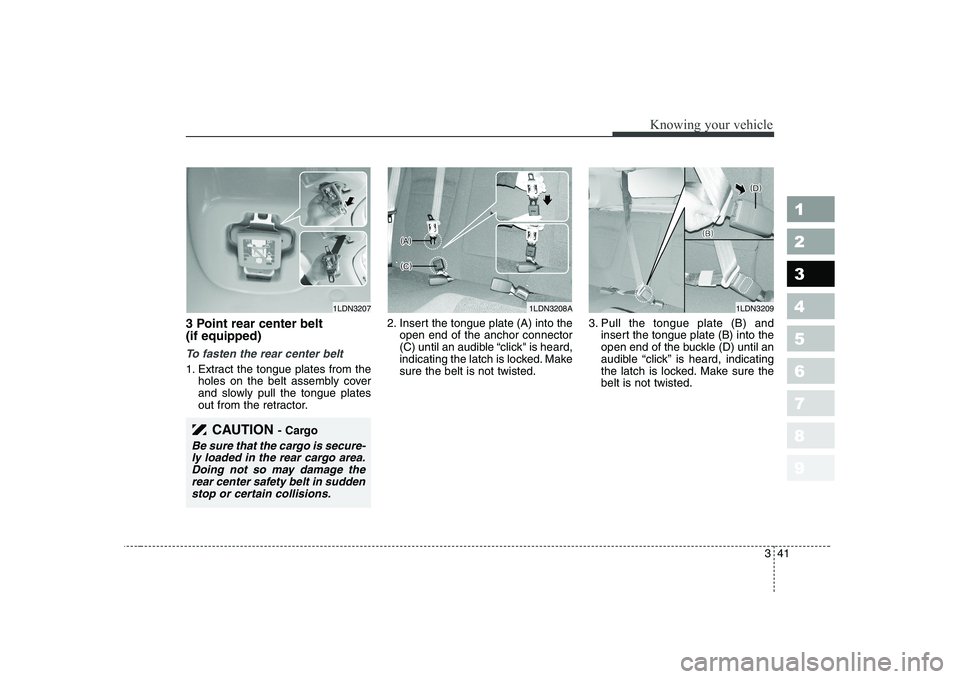
341
1 23456789
Knowing your vehicle
3 Point rear center belt (if equipped)
To fasten the rear center belt
1. Extract the tongue plates from theholes on the belt assembly cover
and slowly pull the tongue plates
out from the retractor. 2. Insert the tongue plate (A) into the
open end of the anchor connector
(C) until an audible “click" is heard,
indicating the latch is locked. Makesure the belt is not twisted. 3. Pull the tongue plate (B) and
insert the tongue plate (B) into the
open end of the buckle (D) until an
audible “click” is heard, indicating
the latch is locked. Make sure thebelt is not twisted.
1LDN32071LDN3208A1LDN3209
CAUTION - Cargo
Be sure that the cargo is secure-
ly loaded in the rear cargo area. Doing not so may damage therear center safety belt in suddenstop or certain collisions.
Page 52 of 327
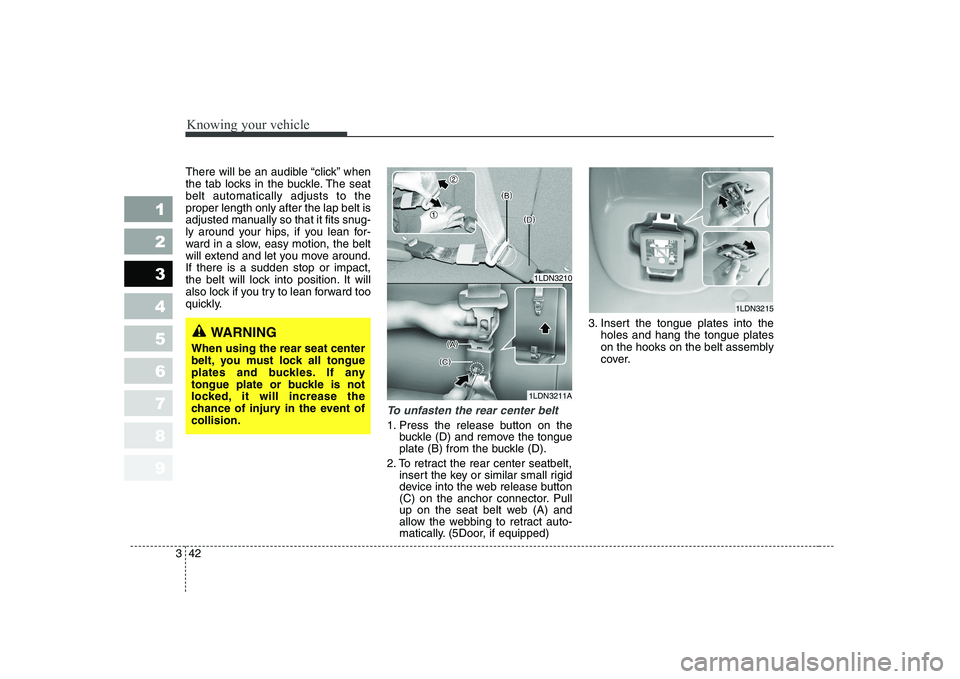
Knowing your vehicle
42
3
1 23456789
There will be an audible “click” when
the tab locks in the buckle. The seatbelt automatically adjusts to theproper length only after the lap belt is
adjusted manually so that it fits snug-
ly around your hips, if you lean for-
ward in a slow, easy motion, the belt
will extend and let you move around.If there is a sudden stop or impact,
the belt will lock into position. It will
also lock if you try to lean forward too
quickly.
To unfasten the rear center belt
1. Press the release button on the
buckle (D) and remove the tongue
plate (B) from the buckle (D).
2. To retract the rear center seatbelt, insert the key or similar small rigid
device into the web release button
(C) on the anchor connector. Pull
up on the seat belt web (A) and
allow the webbing to retract auto-
matically. (5Door, if equipped) 3. Insert the tongue plates into the
holes and hang the tongue plates
on the hooks on the belt assembly
cover.
WARNING
When using the rear seat center
belt, you must lock all tongue
plates and buckles. If any
tongue plate or buckle is not
locked, it will increase the
chance of injury in the event ofcollision.
1LDN3210
1LDN3211A
1LDN3215
Page 53 of 327
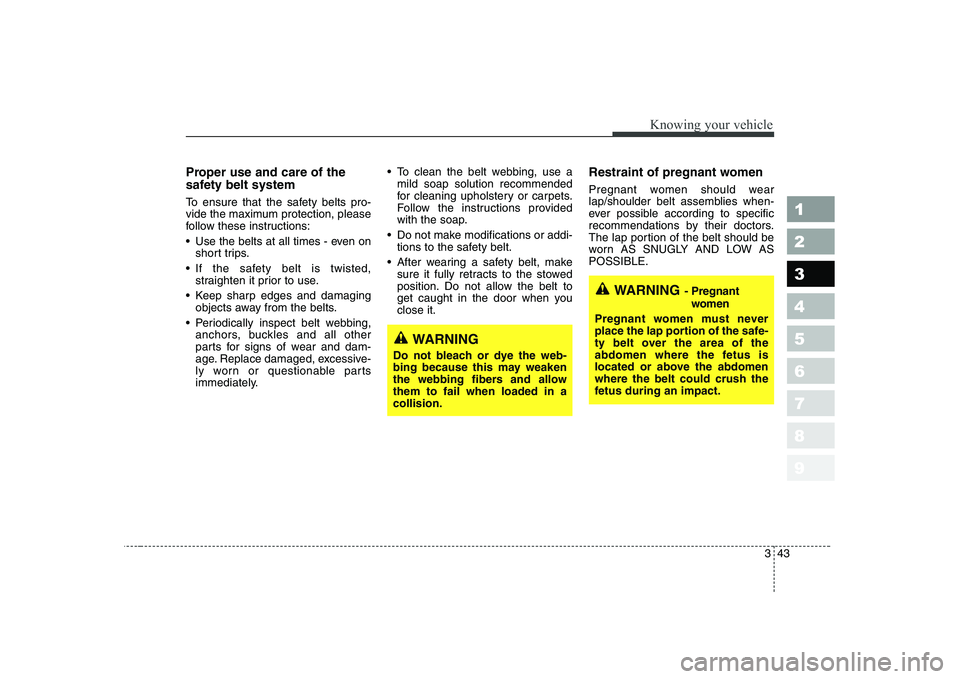
343
1 23456789
Knowing your vehicle
Proper use and care of the
safety belt system
To ensure that the safety belts pro-
vide the maximum protection, please
follow these instructions:
Use the belts at all times - even onshort trips.
If the safety belt is twisted, straighten it prior to use.
Keep sharp edges and damaging objects away from the belts.
Periodically inspect belt webbing, anchors, buckles and all other
parts for signs of wear and dam-
age. Replace damaged, excessive-
ly worn or questionable parts
immediately. To clean the belt webbing, use a
mild soap solution recommended
for cleaning upholstery or carpets.
Follow the instructions provided
with the soap.
Do not make modifications or addi- tions to the safety belt.
After wearing a safety belt, make sure it fully retracts to the stowed
position. Do not allow the belt to
get caught in the door when youclose it. Restraint of pregnant women
Pregnant women should wear
lap/shoulder belt assemblies when-
ever possible according to specific
recommendations by their doctors.
The lap portion of the belt should be
worn AS SNUGLY AND LOW ASPOSSIBLE.
WARNING
- Pregnant
women
Pregnant women must never
place the lap portion of the safe-
ty belt over the area of the
abdomen where the fetus is
located or above the abdomenwhere the belt could crush the
fetus during an impact.
WARNING
Do not bleach or dye the web-
bing because this may weaken
the webbing fibers and allowthem to fail when loaded in acollision.
Page 54 of 327
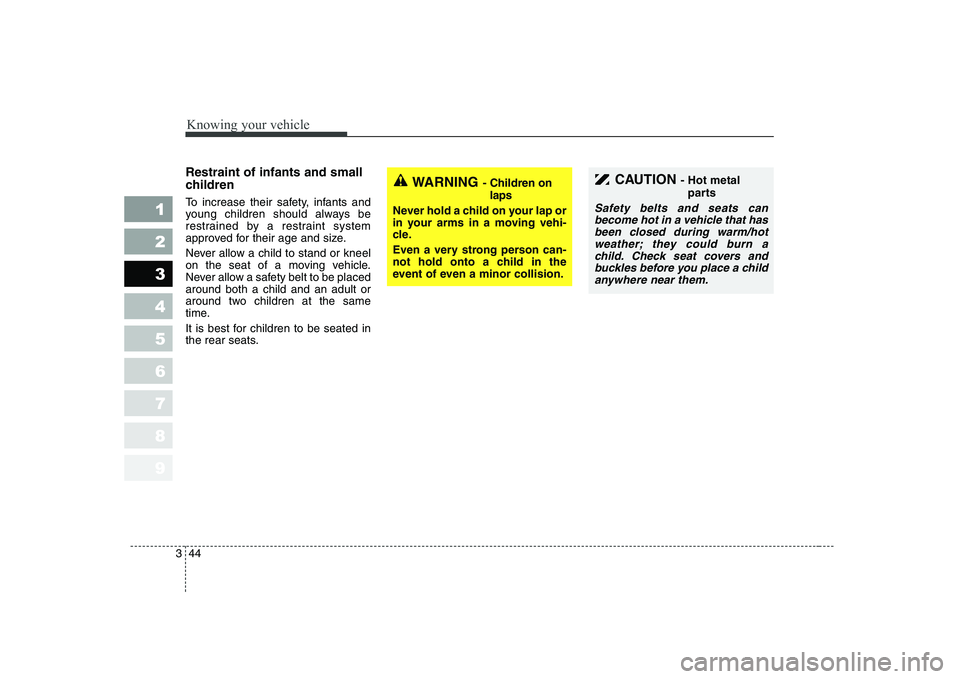
Knowing your vehicle
44
3
1 23456789
Restraint of infants and small
children
To increase their safety, infants and
young children should always be
restrained by a restraint system
approved for their age and size.
Never allow a child to stand or kneel
on the seat of a moving vehicle.
Never allow a safety belt to be placedaround both a child and an adult or
around two children at the same
time.
It is best for children to be seated in
the rear seats.WARNING - Children on
laps
Never hold a child on your lap or
in your arms in a moving vehi-
cle.
Even a very strong person can-
not hold onto a child in the
event of even a minor collision.CAUTION - Hot metal
parts
Safety belts and seats canbecome hot in a vehicle that hasbeen closed during warm/hotweather; they could burn a child. Check seat covers andbuckles before you place a childanywhere near them.
Page 55 of 327
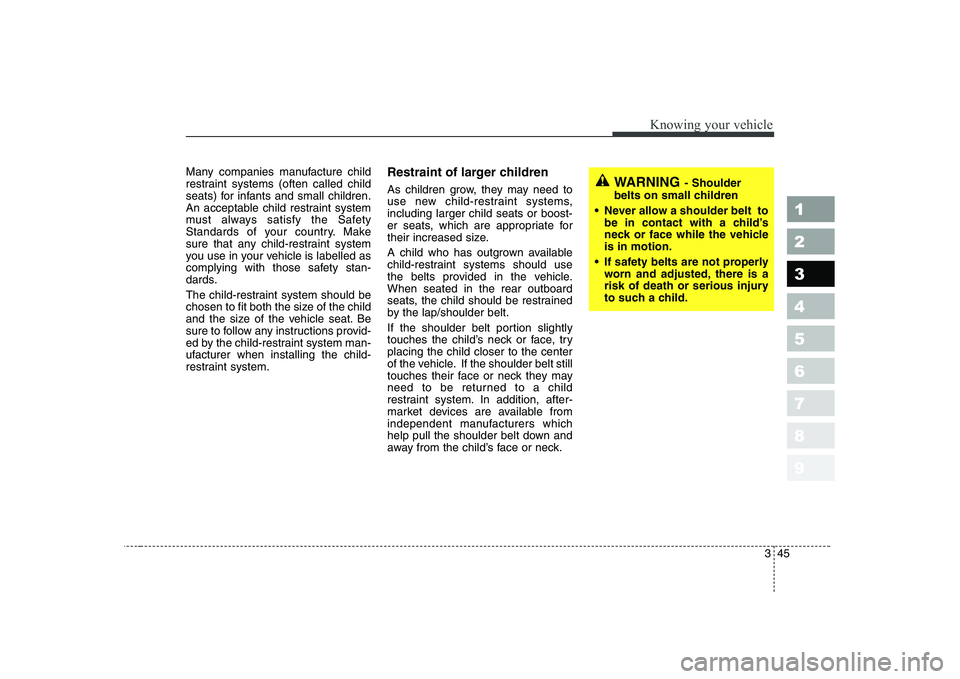
345
1 23456789
Knowing your vehicle
Many companies manufacture child
restraint systems (often called child
seats) for infants and small children.
An acceptable child restraint system
must always satisfy the Safety
Standards of your country. Make
sure that any child-restraint system
you use in your vehicle is labelled as
complying with those safety stan-
dards.
The child-restraint system should be
chosen to fit both the size of the child
and the size of the vehicle seat. Be
sure to follow any instructions provid-
ed by the child-restraint system man-
ufacturer when installing the child-
restraint system.Restraint of larger children
As children grow, they may need to
use new child-restraint systems,including larger child seats or boost-
er seats, which are appropriate for
their increased size.
A child who has outgrown available
child-restraint systems should use
the belts provided in the vehicle.When seated in the rear outboard
seats, the child should be restrained
by the lap/shoulder belt.
If the shoulder belt portion slightly
touches the child’s neck or face, tryplacing the child closer to the center
of the vehicle. If the shoulder belt still
touches their face or neck they may
need to be returned to a child
restraint system. In addition, after-
market devices are available from
independent manufacturers which
help pull the shoulder belt down and
away from the child’s face or neck.WARNING
- Shoulder
belts on small children
Never allow a shoulder belt to be in contact with a child’s
neck or face while the vehicleis in motion.
If safety belts are not properly worn and adjusted, there is a
risk of death or serious injury
to such a child.
Page 56 of 327
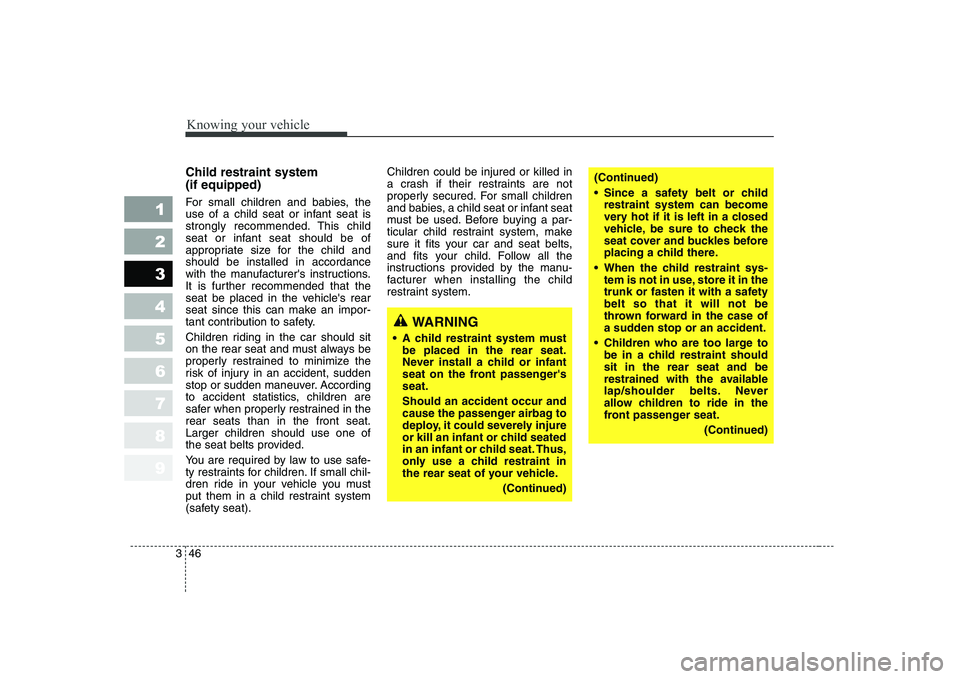
Knowing your vehicle
46
3
1 23456789
Child restraint system (if equipped)
For small children and babies, the
use of a child seat or infant seat is
strongly recommended. This child
seat or infant seat should be of
appropriate size for the child andshould be installed in accordance
with the manufacturer's instructions.
It is further recommended that the
seat be placed in the vehicle's rear
seat since this can make an impor-
tant contribution to safety.
Children riding in the car should sit
on the rear seat and must always be
properly restrained to minimize the
risk of injury in an accident, sudden
stop or sudden maneuver. According
to accident statistics, children are
safer when properly restrained in therear seats than in the front seat.Larger children should use one of
the seat belts provided.
You are required by law to use safe-
ty restraints for children. If small chil-
dren ride in your vehicle you must
put them in a child restraint system
(safety seat). Children could be injured or killed in
a crash if their restraints are not
properly secured. For small children
and babies, a child seat or infant seat
must be used. Before buying a par-
ticular child restraint system, make
sure it fits your car and seat belts,
and fits your child. Follow all the
instructions provided by the manu-
facturer when installing the child
restraint system.
WARNING
A child restraint system must be placed in the rear seat.
Never install a child or infant
seat on the front passenger'sseat. Should an accident occur and
cause the passenger airbag to
deploy, it could severely injure
or kill an infant or child seated
in an infant or child seat. Thus,
only use a child restraint in
the rear seat of your vehicle.
(Continued)
(Continued)
Since a safety belt or childrestraint system can become
very hot if it is left in a closed
vehicle, be sure to check the
seat cover and buckles before
placing a child there.
When the child restraint sys- tem is not in use, store it in the
trunk or fasten it with a safetybelt so that it will not be
thrown forward in the case of
a sudden stop or an accident.
Children who are too large to be in a child restraint shouldsit in the rear seat and be
restrained with the available
lap/shoulder belts. Never
allow children to ride in the
front passenger seat.
(Continued)
Page 57 of 327
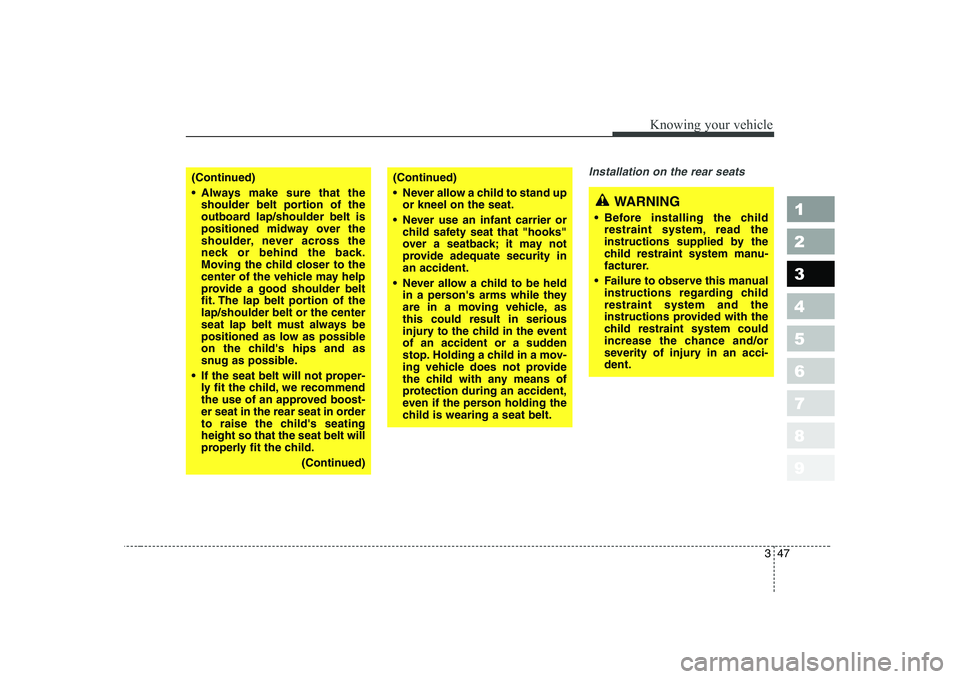
347
1 23456789
Knowing your vehicle
Installation on the rear seats(Continued)
Always make sure that theshoulder belt portion of the
outboard lap/shoulder belt is
positioned midway over the
shoulder, never across the
neck or behind the back.
Moving the child closer to the
center of the vehicle may help
provide a good shoulder belt
fit. The lap belt portion of thelap/shoulder belt or the center
seat lap belt must always be
positioned as low as possible
on the child's hips and as
snug as possible.
If the seat belt will not proper- ly fit the child, we recommend
the use of an approved boost-
er seat in the rear seat in order
to raise the child's seatingheight so that the seat belt will
properly fit the child.
(Continued)(Continued)
Never allow a child to stand upor kneel on the seat.
Never use an infant carrier or child safety seat that "hooks"
over a seatback; it may not
provide adequate security inan accident.
Never allow a child to be held in a person's arms while they
are in a moving vehicle, asthis could result in serious
injury to the child in the event
of an accident or a sudden
stop. Holding a child in a mov-
ing vehicle does not provide
the child with any means of
protection during an accident,
even if the person holding the
child is wearing a seat belt.
WARNING
Before installing the child restraint system, read the
instructions supplied by the
child restraint system manu-
facturer.
Failure to observe this manual instructions regarding childrestraint system and the
instructions provided with the
child restraint system could
increase the chance and/or
severity of injury in an acci-dent.
Page 58 of 327
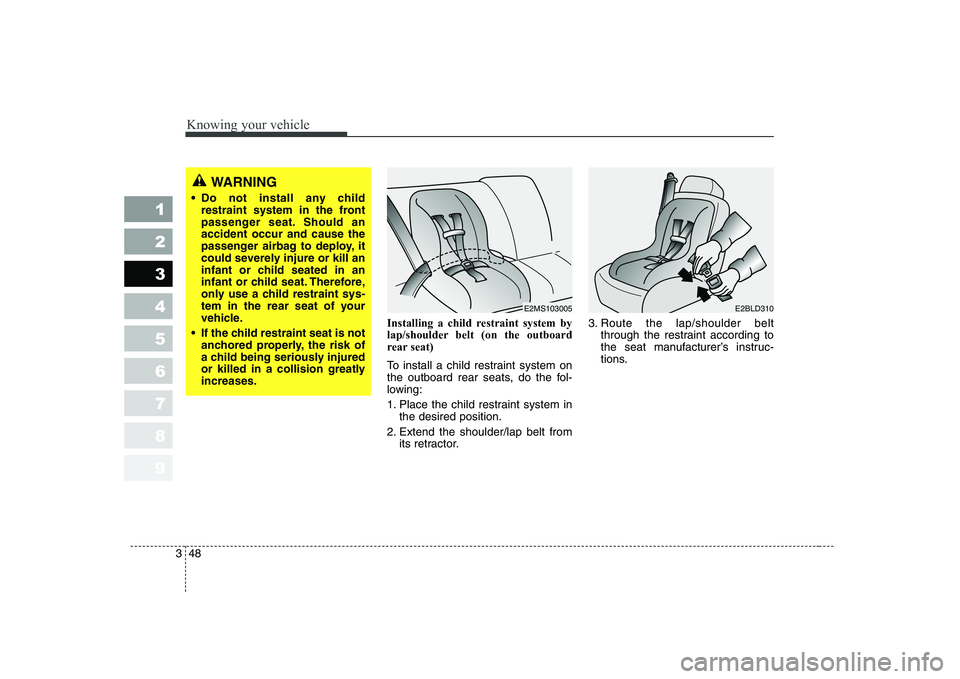
Knowing your vehicle
48
3
1 23456789
Installing a child restraint system by
lap/shoulder belt (on the outboard
rear seat)
To install a child restraint system on
the outboard rear seats, do the fol-
lowing:
1. Place the child restraint system in
the desired position.
2. Extend the shoulder/lap belt from its retractor. 3. Route the lap/shoulder belt
through the restraint according to
the seat manufacturer’s instruc-
tions.
WARNING
Do not install any child restraint system in the front
passenger seat. Should anaccident occur and cause the
passenger airbag to deploy, it
could severely injure or kill an
infant or child seated in an
infant or child seat. Therefore,
only use a child restraint sys-
tem in the rear seat of your
vehicle.
If the child restraint seat is not anchored properly, the risk of
a child being seriously injured
or killed in a collision greatlyincreases.
E2MS103005E2BLD310
Page 59 of 327
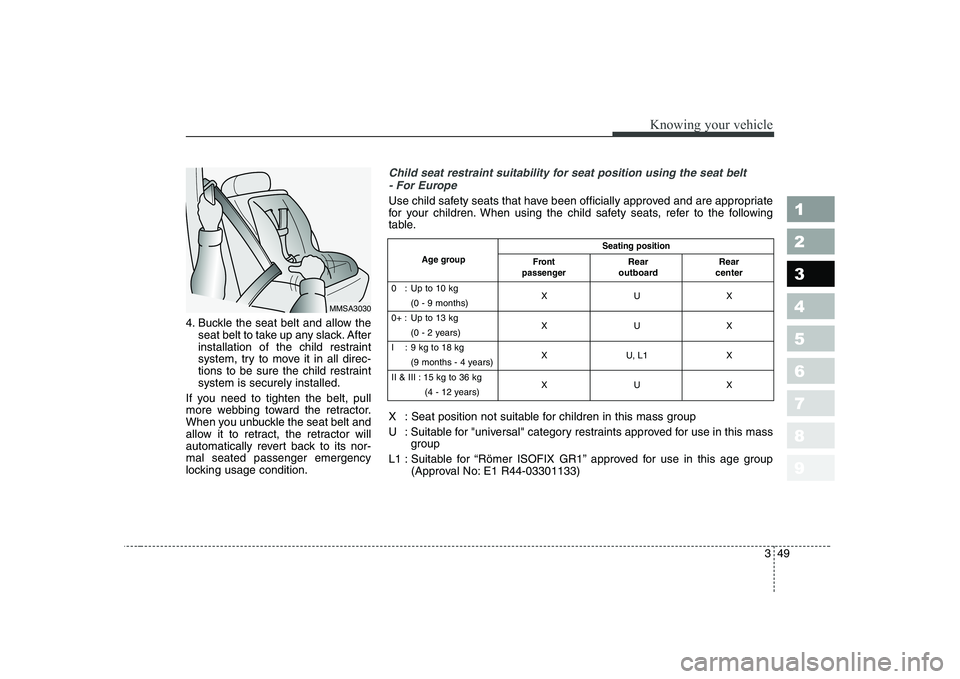
349
1 23456789
Knowing your vehicle
4. Buckle the seat belt and allow theseat belt to take up any slack. After
installation of the child restraint
system, try to move it in all direc-
tions to be sure the child restraintsystem is securely installed.
If you need to tighten the belt, pull
more webbing toward the retractor.
When you unbuckle the seat belt and
allow it to retract, the retractor will
automatically revert back to its nor-mal seated passenger emergency
locking usage condition.
MMSA3030
Child seat restraint suitability for seat position using the seat belt - For Europe
Use child safety seats that have been officially approved and are appropriate
for your children. When using the child safety seats, refer to the following
table.
X : Seat position not suitable for children in this mass group
U : Suitable for "universal" category restraints approved for use in this mass group
L1 : Suitable for “Römer ISOFIX GR1” approved for use in this age group (Approval No: E1 R44-03301133)
Seating position
Age group
0 : Up to 10 kg XUX
(0 - 9 months)
0+ : Up to 13 kg XUX
(0 - 2 years)
I : 9 kg to 18 kg X U, L1 X
(9 months - 4 years)
II & III : 15 kg to 36 kg XUX
(4 - 12 years)
Front
passengerRear
outboard Rear
center
Page 60 of 327
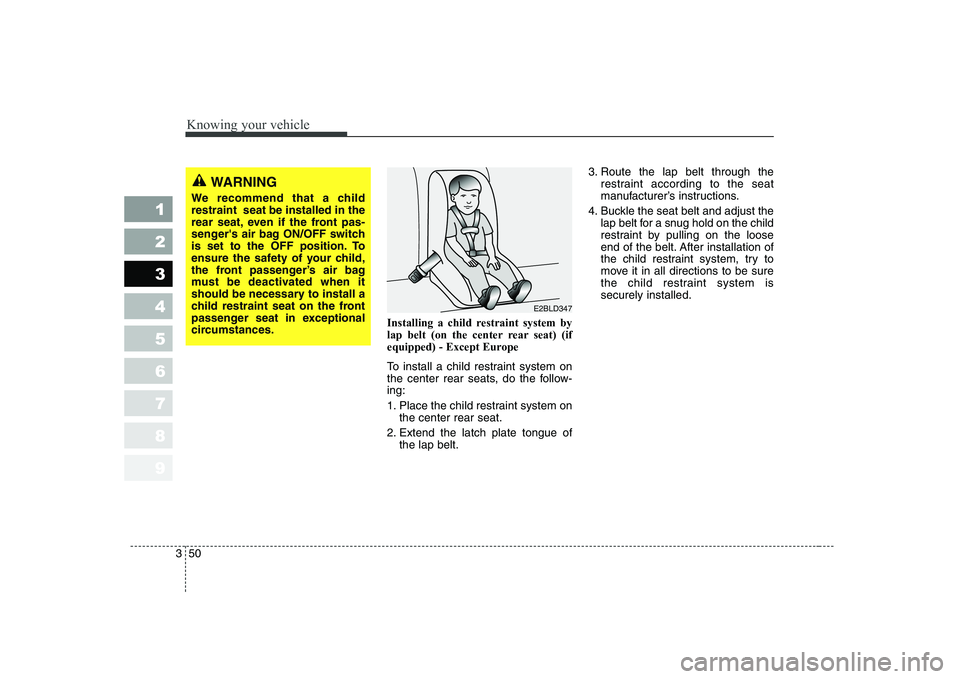
Knowing your vehicle
50
3
1 23456789
Installing a child restraint system by
lap belt (on the center rear seat) (if
equipped) - Except Europe
To install a child restraint system on
the center rear seats, do the follow-ing:
1. Place the child restraint system on
the center rear seat.
2. Extend the latch plate tongue of the lap belt. 3. Route the lap belt through the
restraint according to the seat
manufacturer’s instructions.
4. Buckle the seat belt and adjust the lap belt for a snug hold on the child
restraint by pulling on the loose
end of the belt. After installation of
the child restraint system, try to
move it in all directions to be sure
the child restraint system issecurely installed.
E2BLD347
WARNING
We recommend that a child restraint seat be installed in the
rear seat, even if the front pas-
senger's air bag ON/OFF switch
is set to the OFF position. To
ensure the safety of your child,
the front passenger’s air bag
must be deactivated when it
should be necessary to install a
child restraint seat on the front
passenger seat in exceptional
circumstances.